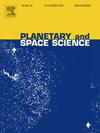Groundwater at the southern pole of the Moon via the gravity strike angles: IM-1 and Artemis
IF 1.7
4区 物理与天体物理
Q3 ASTRONOMY & ASTROPHYSICS
引用次数: 0
Abstract
Gravity strike angles are one of the gravity aspects. They are computed from global static gravity field models. They react to changes in density variation and porosity. Internal rock anisotropy and stresses can be detected by strike angles. They run parallel with the direction of weakness in the strength of the rock, e.g., the direction schistosity and/or the presence of faults or micro-fault zones. Thus, they can help to describe the underground causative body in another way than traditional gravity anomalies. We used the GRGM1200A gravity field model for the Moon to the degree and order of 600 in spherical harmonic expansion and LOLA topography. The results show that the strike angles are more frequently and more intensively aligned (combed) near the poles than in other places. The strike angles are highly combed for the Malapert A crater (the landing site of IM-1/Odyssey) as well as for the localities selected by NASA for the forthcoming Artemis missions. Our method, which has already been applied many times on diverse geological features on the Earth, provides quick and cheap remote sensing procedure, a preliminary diagnostic tool, independent of all others, in search of lunar water.

月球南极地下水的重力走向角:IM-1和阿尔忒弥斯
重力走向角是重力的一个方面。它们是根据全球静态重力场模型计算的。它们对密度变化和孔隙度的变化作出反应。岩石内部各向异性和应力可以通过走向角来检测。它们与岩石强度弱的方向平行,例如,片理方向和/或断层或微断层带的存在。因此,它们可以帮助以另一种方式描述地下成因体,而不是传统的重力异常。我们使用GRGM1200A月球重力场模型,在球谐展开和LOLA地形上进行了600度和600阶的模拟。结果表明,与其他地方相比,靠近两极的走向角排列更频繁、更密集。对马拉珀特A陨石坑(IM-1/奥德赛的着陆点)以及美国宇航局为即将到来的阿尔忒弥斯任务选择的地点的打击角度进行了高度梳理。我们的方法已经多次应用于地球上不同的地质特征,它提供了一种快速而廉价的遥感程序,一种独立于所有其他方法的初步诊断工具,用于寻找月球上的水。
本文章由计算机程序翻译,如有差异,请以英文原文为准。
求助全文
约1分钟内获得全文
求助全文
来源期刊

Planetary and Space Science
地学天文-天文与天体物理
CiteScore
5.40
自引率
4.20%
发文量
126
审稿时长
15 weeks
期刊介绍:
Planetary and Space Science publishes original articles as well as short communications (letters). Ground-based and space-borne instrumentation and laboratory simulation of solar system processes are included. The following fields of planetary and solar system research are covered:
• Celestial mechanics, including dynamical evolution of the solar system, gravitational captures and resonances, relativistic effects, tracking and dynamics
• Cosmochemistry and origin, including all aspects of the formation and initial physical and chemical evolution of the solar system
• Terrestrial planets and satellites, including the physics of the interiors, geology and morphology of the surfaces, tectonics, mineralogy and dating
• Outer planets and satellites, including formation and evolution, remote sensing at all wavelengths and in situ measurements
• Planetary atmospheres, including formation and evolution, circulation and meteorology, boundary layers, remote sensing and laboratory simulation
• Planetary magnetospheres and ionospheres, including origin of magnetic fields, magnetospheric plasma and radiation belts, and their interaction with the sun, the solar wind and satellites
• Small bodies, dust and rings, including asteroids, comets and zodiacal light and their interaction with the solar radiation and the solar wind
• Exobiology, including origin of life, detection of planetary ecosystems and pre-biological phenomena in the solar system and laboratory simulations
• Extrasolar systems, including the detection and/or the detectability of exoplanets and planetary systems, their formation and evolution, the physical and chemical properties of the exoplanets
• History of planetary and space research
 求助内容:
求助内容: 应助结果提醒方式:
应助结果提醒方式:


